ISSN ONLINE(2319-8753)PRINT(2347-6710)
ISSN ONLINE(2319-8753)PRINT(2347-6710)
| Dr. S. K. Chinta, Ms. Pooja D. Gujar D.K.T.E Textile and Engineering Institute, Ichalkaranji, Maharashtra-416115, India |
| Related article at Pubmed, Scholar Google |
Visit for more related articles at International Journal of Innovative Research in Science, Engineering and Technology
Microencapsulation is a process in which tiny particles or a coating to give small capsules with many useful properties surrounds droplets. There are many methods to impart various end use applications like antimicrobial property, flame proof and many more functional properties to the various substrates like polyester, nylon, polypropylene etc., and it may be that most of the application methods may be durable or temporary. The microencapsules can introduce important new qualities to garments and fabrics, such as enhanced stability and the controlled release of active compounds. Microencapsulation technique is a unique one where a controlled release of these properties as and when required are possible and also regarding the durability it can withstand for a longer duration. The present work was carried out with an objective to study the effect of clove oil, neem oil, aloe Vera powder, Benzalkonium Chloride (BKC) with certain physical and performance properties on woven fabrics like cotton, P/C blend fabric and Non-woven Polypropylene fabric by the imparting antimicrobial finish by microencapsulation technique
Keywords |
| Moisture management, Comfort, Wetting, Wicking, Moisture Vapour Transmission |
INTRODUCTION |
| Around the world rapid changes are calling for a different look and a newer feel in both fashion and fabric. Whether it is woven or knitted, the demand is for something new and different in the world of high fashion. As the worldwide business gears to tackle the challenges, product diversification has become the key to global opportunities. The main factors affecting consumers when selecting garments are aesthetic, appearance and fashion. Besides these factors, comfort properties of garments during usage are important. Now-a-days, consumers have become much more demanding when it comes to the properties of clothing, particularly those of leisure and sportswear. One of the textile properties that have steadily gained importance among increasingly well- informed consumers are breathability of the material, because this property seems to be directly linked to comfortable wear of the garment. To be comfortable and to maintain the state of comfort, clothing must be designed to allow the body’s heat balance to be maintained under a wide range of environmental conditions and body activity. It should fulfill this function without inhibiting the evaporation of humidity caused by perspiration (good moisture management), and thus not interfering with the temperature regulation of the body. |
| Moisture management is one of the key performance criteria in today’s apparel industry, which decides the comfort level of that fabric. Wearing garments that transport moisture and evaporate it quickly actually enhance your body’s ability to cool itself. Moisture management can be defined as the controlled movement of water vapour and liquid water (perspiration) from the surface of the skin to the atmosphere through the fabric. This action prevents perspiration from remaining next to the skin. When your body can cool itself more effectively you actually perspire less. as a result. With reduced perspiration your body requires less dehydration, and maintains maximum performance for an extended period of time. Top athletes, emergency personnel and even the military have realized that proper moisture management optimizes physical performance and endurance. |
| The main aim of development of moisture management fabrics is: |
| a) To transport the humidity to the atmosphere as fast as possible |
| b) To evaporate the humidity as early as possible |
| c) To make the skin feel dry |
| Moisture management can include the use of microfiber technology or the application of various softening finishes like silicones at the molecular level to enhance both hydrophobic and hydrophilic properties of a fabric. Hydrophilic fabrics or waterproof breathable fabrics are some advances in the field of moisture management in textiles. Water-resistant and moisture-permeable materials may be divided into three main categories - high-density fabrics, resin-coated materials and film-laminated materials which are selected by manufacturers according to finished garment requirements in casual, athletic, ski or outdoor apparel. |
| One of the ways of improving moisture management property of a fabric is by applying softener finishing on it. A softener is defined as an auxiliary that when applied to textile material improves its handle with more pleasing touch. Fabric softeners have been used to impart good softening characteristics of various fibres to get desired handle, wherein they help as fibre lubricants, overcome the harshness imparted by natural oils during scouring and also overcome the rigidity imparted by resin finishing. Several studies have been made to measure the effect of fabric constructions or finishes on changes in hand and correlations were generally good between these mechanical properties and sensory hand response. The present article is the outcome of an investigation carried out with the objectives of studying the moisture management properties of cotton and blended fabrics finished with various types of softeners. |
II. MATERIALS AND METHODS |
| 2.1 Materials |
| 2.1.1 Fabrics A total number of four different types of scoured and bleached fabrics- 133GSM cotton(warp count -32 Nes, weft count- 29 Nes, 104 ends/inch, 68 picks/inch, plain weave), 263 GSM cotton(warp count -19 Nes, weft count- 10 Nes, 112 ends/inch, 52 picks/inch, twill weave) and blended fabrics like 100 GSM polyester/viscose(warp count - 49 Nes, weft count- 56 Nes, 100 ends/inch, 84 picks/inch, plain weave), 63 GSM polyester/cotton(warp count -74 Nes, weft count- 59 Nes, 96 ends/inch, 72 picks/inch, plain weave) blended fabrics were selected for the study. |
| 2.1.2 Chemicals Different softeners like anionic, non- ionic, reactive, reactive softener + glycerin, amino silicone, amino silicone + glycerin, micro amino silicone, micro silicone softener, Silkofeel HP 387 (hydrophilic silicone), Silkofeel HP 678(hydrophilic silicone) and PE emulsion softener were used. All softeners were of industrial grade. |
| 2.2Methods Softening Treatment The softening treatment was given using pad- dry- cure method. The concentrations of all softeners were varied from 10 gpl, 20 gpl, 30 gpl and 40 gpl. The pH of the solution was maintained at 5.5 using small quantity of acetic acid. The treated samples were padded at constant pressure to achieve 60 % expression. The curing temperature for reactive softener was maintained at 160ºc for 60 Sec while remaining softeners were dry cum cured at 80 ºc for 60 Sec. |
III. TESTING |
| All the finished fabrics were tested for the various moisture managing properties in standard atmospheric condition of 65±2% RH and 25±2 ºc temperature. The properties tested were as follows |
| 3.1 Air Permeability Air permeability of treated fabrics was measured in terms of cm³/cm²/s, using Air Permeability Tester using ASTM D 737 test standard. The specimen was clamped over the test head opening by pressing down the clamping arm which automatically started the vacuum pump. The pre- selected test pressure was automatically maintained and after a few seconds the air permeability of the test specimen was digitally displayed on the screen. This air permeability was measured at different positions for each specimen. |
| 3.2 Wickability Test Vertical wicking is one of the most widely used test method for describing the wickability of fabric. The strip test is employed to measure the wickability of fabrics using DIN 53925 test standard. In which a sample of 20 cm x 2.5 cm was suspended vertically with its lower end immersed in a reservoir of distilled water containing red dye. Water is transported by the immersed fabric and travels vertically against gravity. The height achieved by water in particular time is recorded at specified intervals. |
| 3.3 Drop Test A drop of water is allowed to fall from a fixed height onto the taut surface of a test specimen. The time required for the specular reflection of the water drop to disappear is measured and recorded as water absorbency time. It was measured by the standard method AATCC 79-2000. |
| 3.4 Moisture Regain/ Moisture Content The moisture content and moisture regain of each sample is measured in standard atmospheric condition using ASTM D 2495 test standard. |
| 3.5 Perspiration Fastness Fabric samples were evaluated for perspiration fastness for both acidic and alkaline perspiration using ISO 105- E04 1994 Standard method. |
| 3.6 Whiteness Index Fabric samples were evaluated for Whiteness Index by using Computer Colour Matching (CCM) system as per the ASTM D1925 method. |
IV. RESULT AND DISCUSSION |
| The untreated and finished fabrics were subjected to various tests to analyse the comfort and handle properties and the results are discussed below |
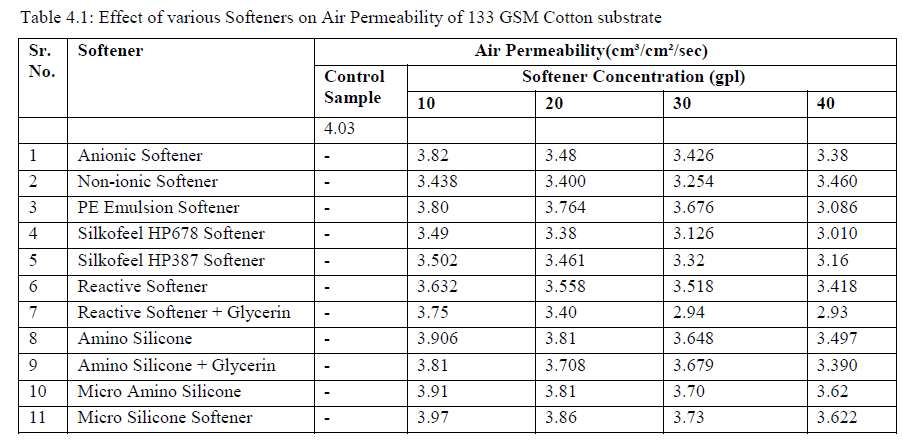 |
| Results of table 4.1 indicate that for 133 GSM cotton fabrics treated with various softeners, the value of air permeability decreases as the softener concentration increases from 10 gpl to 40 gpl. The anionic softener shows that there is decrease in air permeability value from 3.82 to 3.38cm³/cm²/sec. The Silkofeel HP678 softener shows the same trend as 3.49 to 3.01cm³/cm²/sec. The minimum value of air permeability was found to be 3.01cm³/cm²/Sec at 40 gpl concentrations of Silkofeel HP678 softener. The other softeners have shown more values of air permeability as compared with that of Silkofeel HP678.The reason behind this may be the swelling of fibres due to hydrophilic silicone group present in Silkofeel HP678 softener which the air spaces between fibres resulting in decrease in air permeability. |
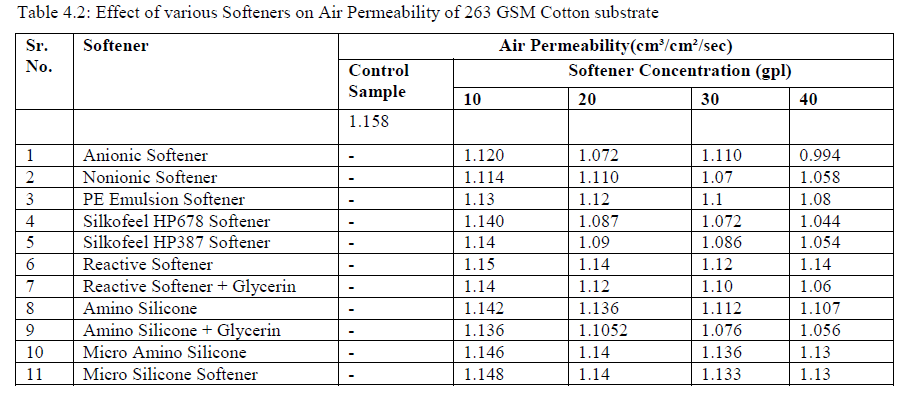 |
| Results of table 4.2 indicate that for 263 GSM cotton fabrics treated with various softeners, the value of air permeability decreases as the softener concentration increases from 10 gpl to 40 gpl. The anionic softener shows that there is decrease in air permeability value from 1.12 to 0.994cm³/cm²/sec. The Silkofeel HP678 softener shows the same trend as 1.14 to 1.044cm³/cm²/sec. The minimum value of air permeability was found to be 1.044cm³/cm²/sec at 40 gpl concentration of Silkofeel HP678 softener. The other softeners have shown more values of air permeability as compared with that of Silkofeel HP678. The reason behind this may be the swelling of fibres due to hydrophilic silicone group present in Silkofeel HP678 softener which the air spaces between fibres resulting in decrease in air permeability. |
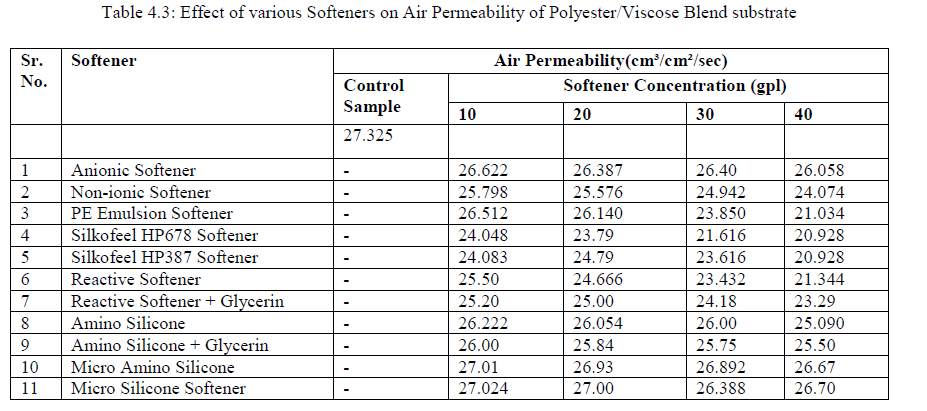 |
| Results of table 4.3 indicate that for 100 GSM cotton fabrics treated with various softeners, the value of air permeability decreases as the softener concentration increases from 10 gpl to 40 gpl. The anionic softener shows that there is a decrease in air permeability value from 26.622 to 26.058 cm³/cm²/Sec. The Silkofeel HP678 softener shows the same trend as 24.048 to 20.928cm³/cm²/sec. The minimum value of air permeability was found to be 20.928cm³/cm²/sec at 40 gpl concentration of Silkofeel HP678 softener. The other softeners have shown more values of air permeability as compared with that of Silkofeel HP678. The reason behind this may be the swelling of fibres due to hydrophilic silicone group present in Silkofeel HP678 softener which the air spaces between fibres resulting in decrease in air permeability. |
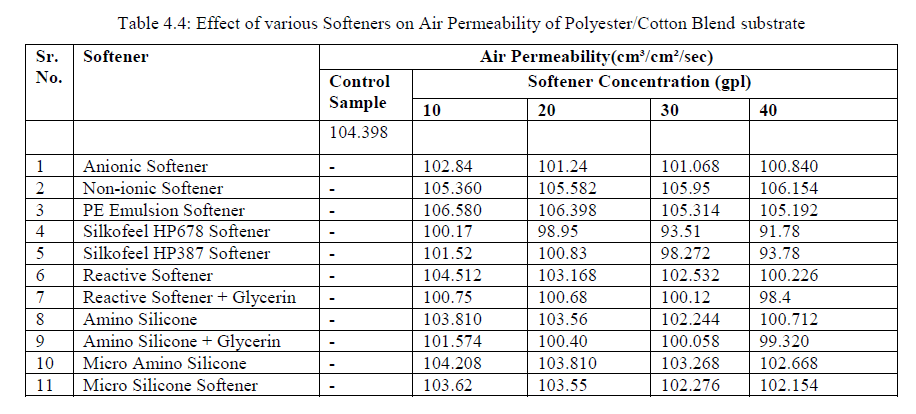 |
| Results of table 4.4 indicate that for 133 GSM cotton fabrics treated with various softeners, the value of air permeability decreases as the softener concentration increases from 10 gpl to 40 gpl. The anionic softener shows that there is a decrease in air permeability value from 3.82 to 3.38cm³/cm²/Sec. The Silkofeel HP678 softener shows the same trend as 3.49 to 3.01cm³/cm²/sec. The minimum value of air permeability was found to be 3.01cm³/cm²/Sec at 40 gpl concentrations of Silkofeel HP678 softener. The other softeners have shown more values of air permeability as compared with that of Silkofeel HP678. The reason behind this may be the swelling of fibres due to hydrophilic silicone group present in Silkofeel HP678 softener which the air spaces between fibres resulting in decrease in air permeability. |
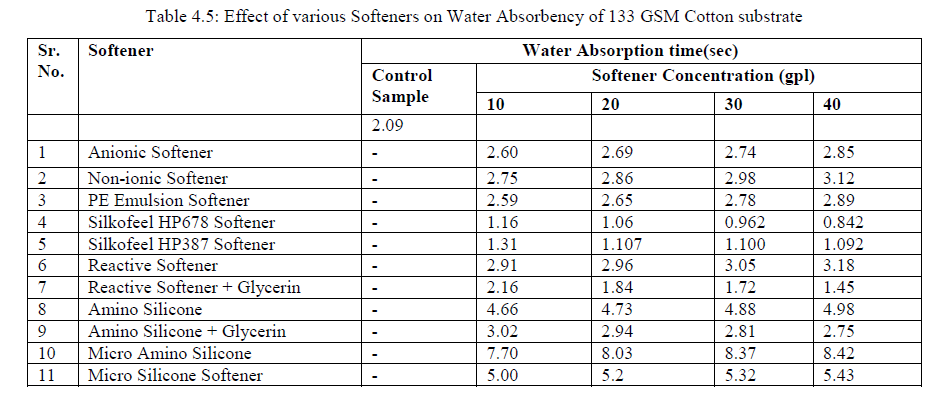 |
| Results of table 4.5 indicate the values of time required to make the drop of water disappear from the surface of cotton fabric treated with various softeners, at different softener concentrations from 10 gpl to 40 gpl. The Micro Amino Silicone softener shows the highest values of water absorption time as 7.70 sec, 8.03 sec, 8.37 sec and 8.42 sec for concentrations 10 gpl, 20 gpl, 30 gpl and 40 gpl respectively. The reason for this may be the increase in the hydrophobic nature of cotton fabric due to application of Micro Amino Silicone softener. The Silkofeel HP678 softener shows the lowest values of water absorption time as 1.16 sec, 1.06 sec, 0.962 sec and 0.842 sec for concentrations 10 gpl, 20 gpl, 30 gpl and 40 gpl respectively among all the softeners. This might be due to the increase in the hydrophilicity of cotton fabric by the hydrophilic group present in Silkofeel HP678 softener. |
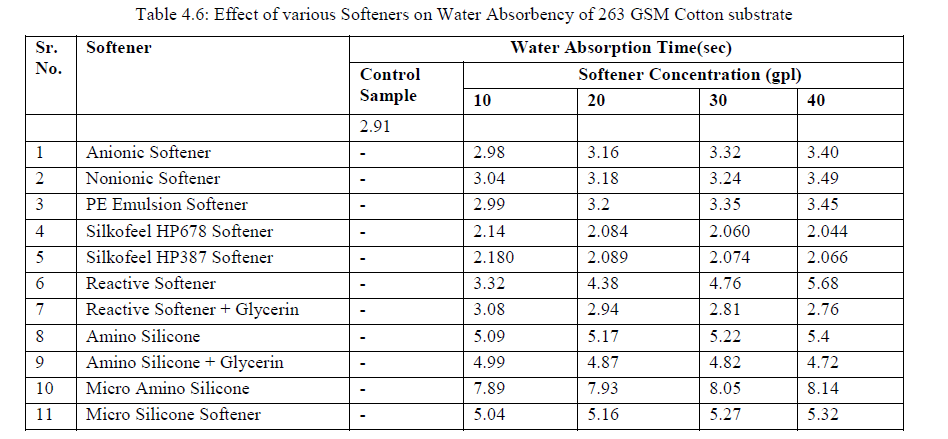 |
| Results of table 4.6 indicate the values of time required to make the drop of water disappear from the surface of cotton fabric treated with various softeners, at different softener concentrations from 10 gpl to 40 gpl. The Micro Amino Silicone softener shows the highest values of water absorption time as 7.89 sec, 7.93 sec, 8.05 sec and 8.14 sec for concentrations 10 gpl, 20 gpl, 30 gpl and 40 gpl respectively. The reason for this may be the increase in the hydrophobic nature of cotton fabric due to application of Micro Amino Silicone softener.The Silkofeel HP678 softener shows the lowest values of water absorption time as 2.14 sec, 2.084 sec, 2.060 sec and 2.044 sec for concentrations 10 gpl, 20 gpl, 30 gpl and 40 gpl respectively among all the softeners. This might be due to the increase in the hydrophilicity of cotton fabric by the hydrophilic group present in Silkofeel HP678 softener. |
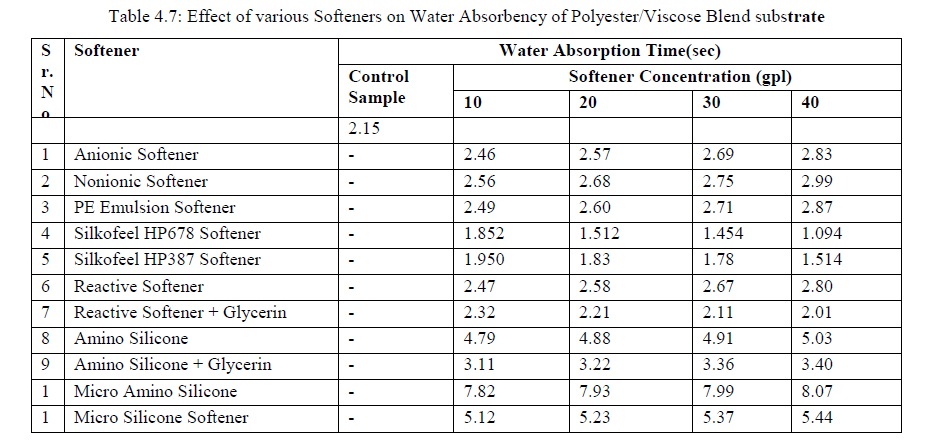 |
| Results of table 4.7 indicate the values of time required to make the drop of water disappear from the surface of cotton fabric treated with various softeners, at different softener concentrations from 10 gpl to 40 gpl. The Micro Amino Silicone softener shows the highest values of water absorption time as 7.82 sec, 7.893 sec, 7.99 sec and 8.07 sec for concentrations 10 gpl, 20 gpl, 30 gpl and 40 gpl respectively. The reason for this may be the increase in the hydrophobic nature of cotton fabric due to application of Micro Amino Silicone softener.The Silkofeel HP678 softener shows the lowest values of water absorption time as 1.852 sec, 1.512 sec, 1.454 sec and 1.094 sec for concentrations 10 gpl, 20 gpl, 30 gpl and 40 gpl respectively among all the softeners. This might be due to the increase in the hydrophilicity of cotton fabric by the hydrophilic group present in Silkofeel HP678 softener. |
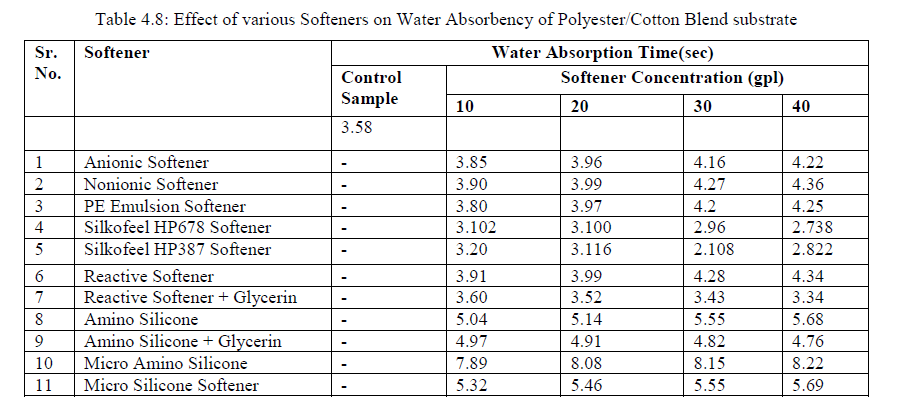 |
| Results of table 4.8 indicate the values of time required to make the drop of water disappear from the surface of cotton fabric treated with various softeners, at different softener concentrations from 10 gpl to 40 gpl. The Anionic softener shows the highest values of water absorption time as 7.70 sec, 8.03 sec, 8.37 sec and 8.42 sec for concentrations 10 gpl, 20 gpl, 30 gpl and 40 gpl respectively. The reason for this may be the increase in the hydrophobic nature of cotton fabric due to application of Micro Amino Silicone softener. The Silkofeel HP678 softener shows the lowest values of water absorption time as 1.16 sec, 1.06 sec, 0.962 sec and 0.842 sec for concentrations 10 gpl, 20 gpl, 30 gpl and 40 gpl respectively among all the softeners. This might be due to the increase in the hydrophilicity of cotton fabric by the hydrophilic group present in Silkofeel HP678 softener. |
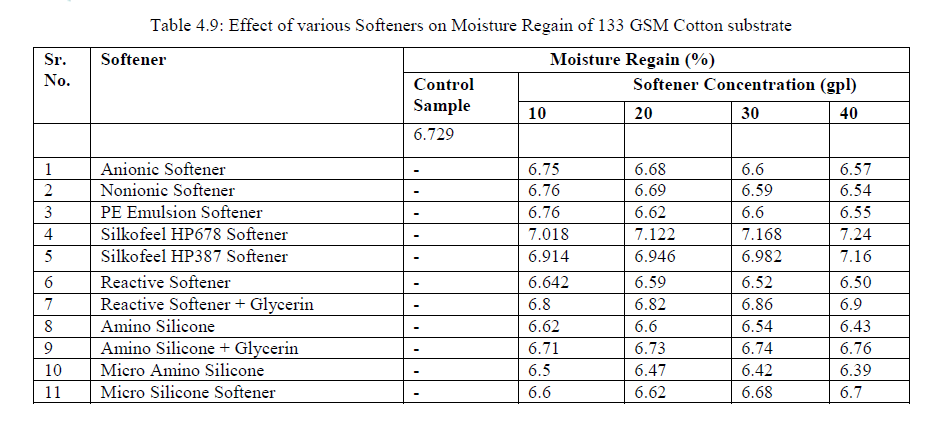 |
| Results of table 4.9 indicate the moisture regain values of 133 GSM cotton fabrics treated with various softeners at various softener concentrations from 10 gpl to 40 gpl. Micro Amino Silicone softener shows the lowest values of moisture regain as 6.5%, 6.47 %, 6.42% and 6.39% for concentrations 10 gpl, 20 gpl, 30 gpl and 40 gpl respectively. The possible reason for this may be the increase in the hydrophobicity of the fabric due to the hydrophobic group present in this softener. Silkofeel HP678 softener shows the highest values of moisture regains as 7.018%, 7.12%, 7.16% and 7.24% for concentrations 10 gpl, 20 gpl, 30 gpl and 40 gpl respectively. The reason behind this may the increase in the hydrophilicity of the fabric due to the hydrophilic group present in Silkofeel HP678 softener which allows the moisture to absorb. Nearly similar results are shown by Silkofeel HP 387 softener. |
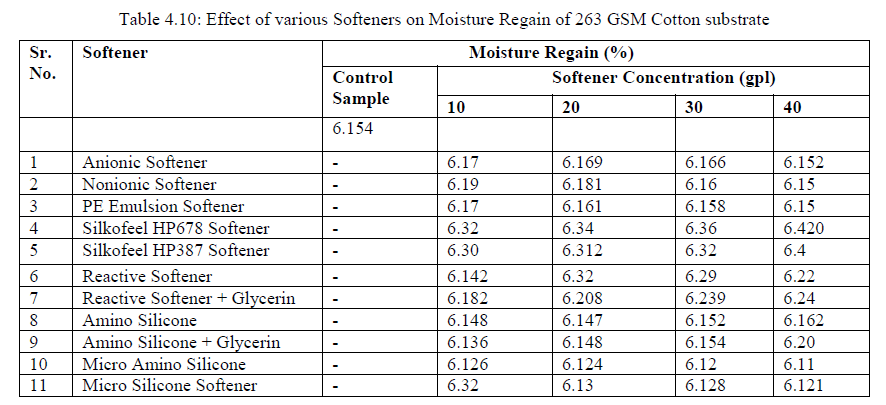 |
| Results of table 4.10 indicate the moisture regain values of 263 GSM cotton fabrics treated with various softeners at various softener concentrations from 10 gpl to 40 gpl. Micro amino silicone softener shows the lowest values of moisture regain as 6.126%, 6.124%, 6.12% and 6.11% for concentrations 10 gpl, 20 gpl, 30 gpl and 40 gpl respectively. The possible reason for this may be the increase in the hydrophobicity of the fabric due to the hydrophobic group present in this softener. Silkofeel HP678softener shows the highest values of moisture regains as 6.32%, 6.34%, 6.36% and 6.42% for concentrations 10 gpl, 20 gpl, 30 gpl and 40 gpl respectively. The reason behind this may the increase in the hydrophilicity of the fabric due to the hydrophilic group present in Silkofeel HP678 softener which allows the moisture to absorb. Nearly similar results are shown by Silkofeel HP 387 softener. |
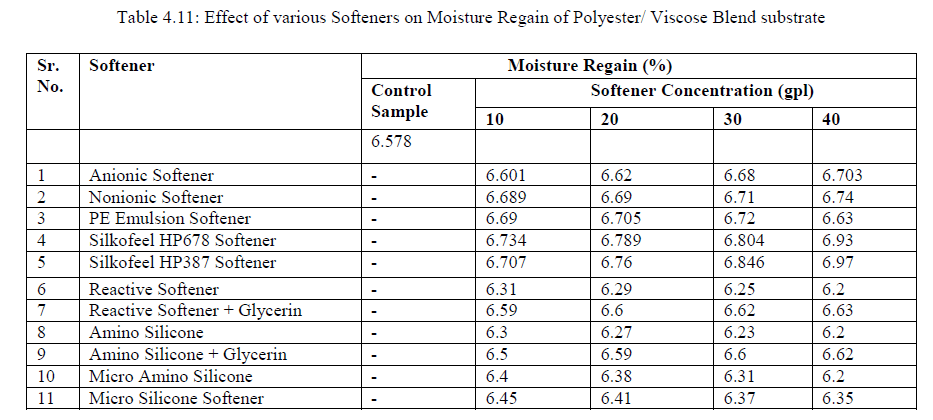 |
| Results of table 4.11 indicate the moisture regain values of 100 GSM polyester/cotton blend fabrics treated with various softeners at various softener concentrations from 10 gpl to 40 gpl. Micro amino silicone softener shows the lowest values of moisture regain as 6.4%, 6.38 %, 6.31% and 6.2% for concentrations 10 gpl, 20 gpl, 30 gpl and 40 gpl respectively. The possible reason for this may be the increase in the hydrophobicity of the fabric due to the hydrophobic group present in this softener. Silkofeel HP678 softener shows the highest values of moisture regains as 6.734%, 6.78%, 6.80% and 6.93% for concentrations 10 gpl, 20 gpl, 30 gpl and 40 gpl respectively. The reason behind this may the increase in the hydrophilicity of the fabric due to the hydrophilic group present in Silkofeel HP678 softener which allows the moisture to absorb. Nearly similar results are shown by Silkofeel HP 387 softener. |
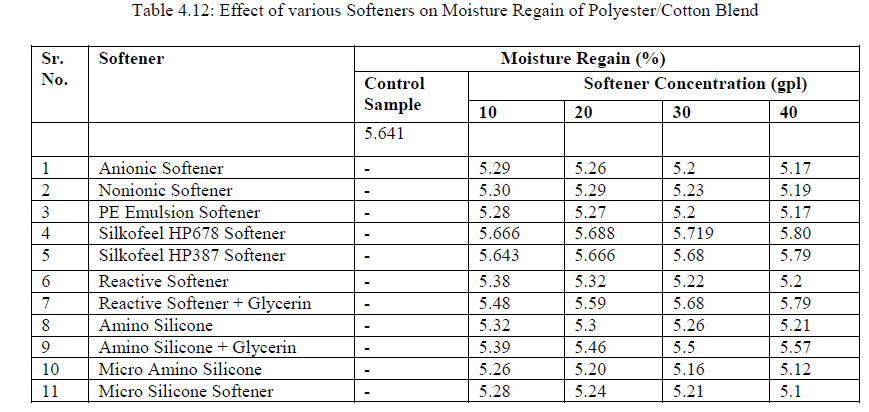 |
| Results of table 4.12 indicate the moisture regain values of 63 GSM polyester/cotton fabrics treated with various softeners at various softener concentrations from 10 gpl to 40 gpl. Micro amino silicone softener shows the lowest values of moisture regain as 5.26%, 5.20 %, 5.16% and 5.12% for concentrations 10 gpl, 20 gpl, 30 gpl and 40 gpl respectively. The possible reason for this may be the increase in the hydrophobicity of the fabric due to the hydrophobic group present in this softener. Silkofeel HP678 softener shows the highest values of moisture regains as 5.66%, 6.68%, 5.71% and 5.80% for concentrations 10 gpl, 20 gpl, 30 gpl and 40 gpl respectively. The reason behind this may the increase in the hydrophilicity of the fabric due to the hydrophilic group present in Silkofeel HP678 softener which allows the moisture to absorb. Nearly similar results are shown by Silkofeel HP 387 softener. |
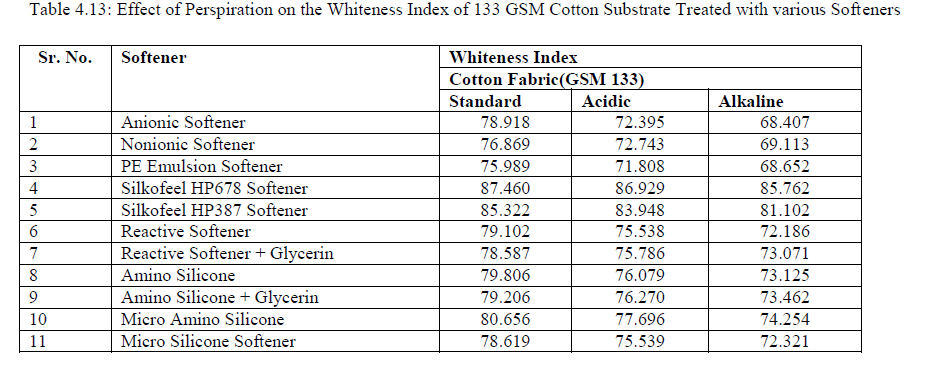 |
| Results of table 4.13 indicate the effect of perspiration on the whiteness index of 133GSM cotton substrate treated with various softeners. For Anionic softener the values of whiteness index are 78.918, 72.395, and 68.407 for standard, acidic and alkaline perspiration solutions respectively. For Silkofeel HP 678 softener the values of whiteness index are 87.460, 86.929, and 85.762 for standard, acidic and alkaline perspiration solutions respectively. The reason for this may be the decrease in the whiteness of fabric after softener treatment. For acidic perspiration there is less reduction in whiteness of fabric as compared to alkaline perspiration. More prominent results are shown by Silkofeel HP 678 softener where the reduction in whiteness index is less for both acidic and alkaline conditions as compared to all other softeners. |
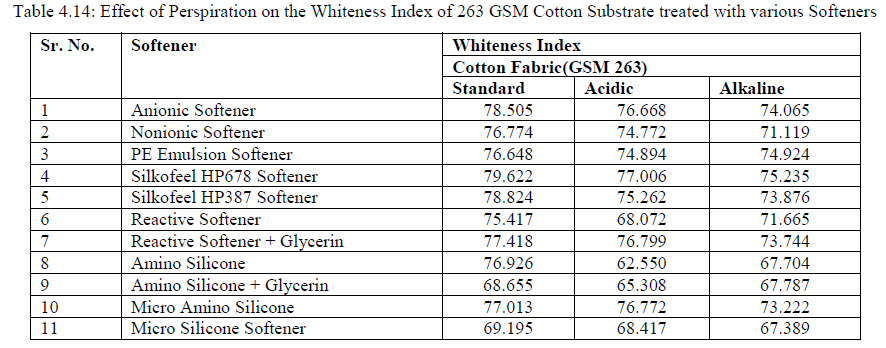 |
| Results of table 4.14 indicate the effect of perspiration on the whiteness index of 263GSM cotton substrate treated with various softeners. For Anionic softener the values of whiteness index are 78.505, 76.668 and 74.065 for standard, acidic and alkaline perspiration solutions respectively. For Silkofeel HP 678 softener the values of whiteness index are 79.622, 77.006 and 75.235 for standard, acidic and alkaline perspiration solutions respectively. The reason for this may be the decrease in the whiteness of fabric after softener treatment. For acidic perspiration there is less reduction in whiteness of fabric as compared to alkaline perspiration. More prominent results are shown by Silkofeel HP 678 softener where the reduction in whiteness index is less for both acidic and alkaline conditions as compared to all other softeners. |
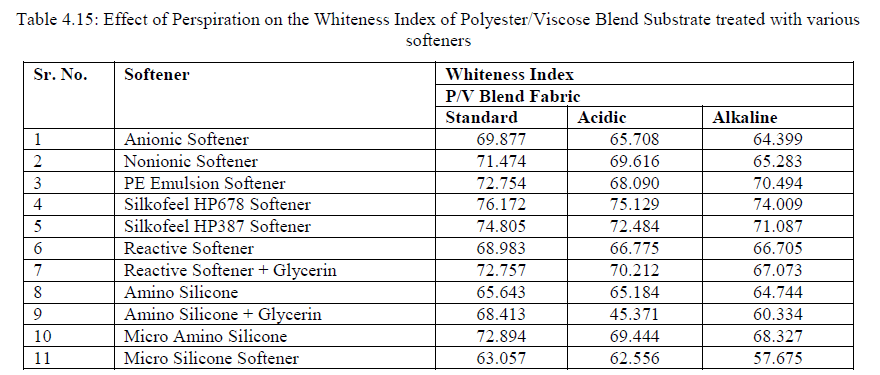 |
| Results of table 4.15 indicate the effect of perspiration on the whiteness index of 100 GSM polyester/viscose blend substrate treated with various softeners. For Anionic softener the values of whiteness index are 69.877, 65.708, 64.399for standard, acidic and alkaline perspiration solutions respectively. For Silkofeel HP 678 softener the values of whiteness index are 76.172, 75.129, and 74.009 for standard, acidic and alkaline perspiration solutions respectively. The reason for this may be the decrease in the whiteness of fabric after softener treatment. For acidic perspiration there is less reduction in whiteness of fabric as compared to alkaline perspiration. More prominent results are shown by Silkofeel HP 678 softener where the reduction in whiteness index is less for both acidic and alkaline conditions as compared to all other softeners. |
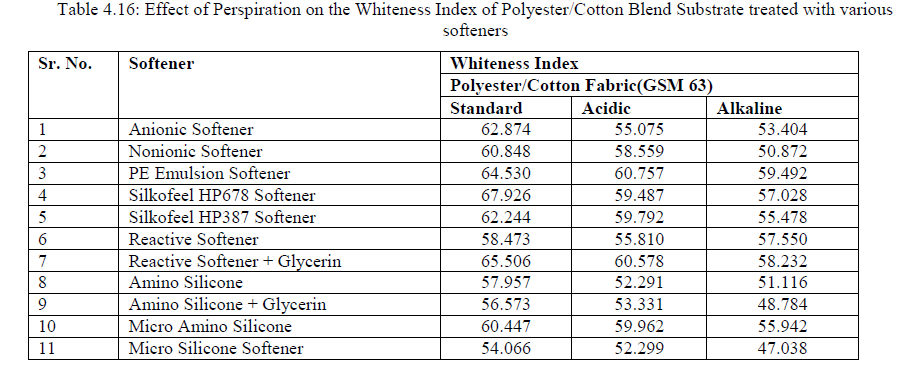 |
| Results of table 4.16 indicate the effect of perspiration on the whiteness index of 63GSM polyester/cotton blend substrate treated with various softeners. For Anionic softener the values of whiteness index are 62.874, 55.075, 53.404for standard, acidic and alkaline perspiration solutions respectively. For Silkofeel HP 678 softener the values of whiteness index are 67.926, 57.028, and 59.487 for standard, acidic and alkaline perspiration solutions respectively. The reason for this may be the decrease in the whiteness of fabric after softener treatment. For acidic perspiration there is less reduction in whiteness of fabric as compared to alkaline perspiration. More prominent results are shown by Silkofeel HP 678 softener where the reduction in whiteness index is less for both acidic and alkaline conditions as compared to all other softeners. |
V. CONCLUSION |
| From the results it is evident that variation in the softeners and softener concentration affects the moisture management properties of fabrics. The findings are summarized as follows: |
| a) Silkofeel HP 678 softener shows a better performance in all comfort properties like reduced air permeability, lesser water absorption time, good moisture regain and lesser effect of perspiration on the whiteness index of fabric. |
| b) 133 GSM Cotton substrate shows highest moisture management properties followed by Polyester/viscose Blend, 263 GSM Cotton and Polyester/cotton Blend fabrics. |
References |
|